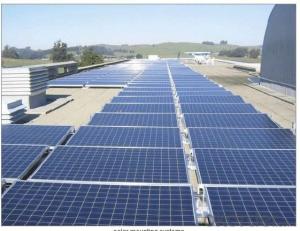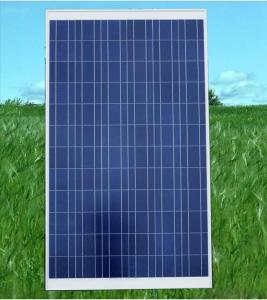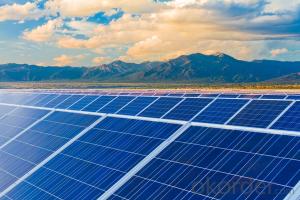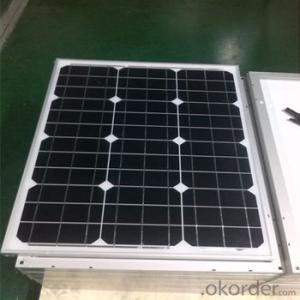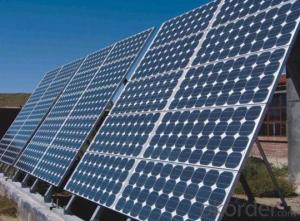(40W) CNBM Solar Polycrystalline 6 Series
- Loading Port:
- China main port
- Payment Terms:
- TT OR LC
- Min Order Qty:
- 100000 watt
- Supply Capability:
- 10000000 watt/month
OKorder Service Pledge
OKorder Financial Service
You Might Also Like
About us
CNBM International Corp, established in 2004, is the business entity for trade and logistic of CNBM Group.With the advantages in Cement, Composite Materials, New Building Materials and Engineering, CNBM mainly concentrate on coal, steel and construction equipments and give priority to solar and wind energy development.CNBM International is highly recognized by its business partners and clients all over the world and has established good business relationship with the customers in over 120 countries and regions all over the world.
Work Principle
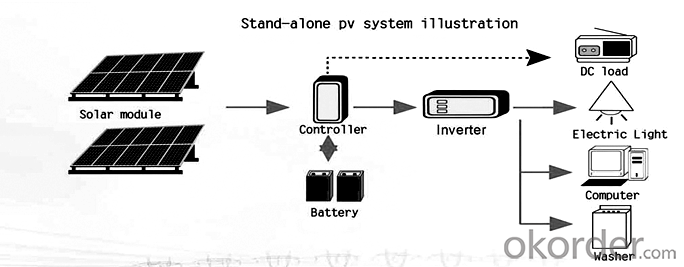
Data sheet
| Characteristics | |
| Max Power Voltage Vmp (V) | 17.4V |
| Max Power Current Imp (A) | 2.30A |
| Open Circuit Voltage Voc (V) | 22.4V |
| Short Circuit Current Isc (A) | 2.46A |
| Max Power Pm (W) | 40W |
| Temperature Coefficient of Cells | |
| NOCT | 47℃±2℃ |
| Temperature Coefficients of Isc (%/℃) | 0.06% |
| Temperature Coefficients of Voc (%/℃) | -0.33% |
| Temperature Coefficients of Pmp (%/℃) | -0.45% |
| Mechanical Data | |
| Type of Cells (mm) | Poly156×44.6 |
| Dimension | 610×510×30mm |
| Weight | 4.5kg |
| NO.of Cells and Connections | 3×12=36 |
| Limits | |
| Operating Temperature | –45°C to +80°C |
| Storage Temperature | –45°C to +80°C |
| Max System Voltage | 700V |
· Characteristics of Polycrystalline Silicon Solar Panel
I Solar Cell : High efficiency crystalline solar cell. Even if under the weak light, the solar module can produce maximum power output.
II Tempered glass (toughened glass): Anti-reflecting coating and high transmission rate glass increase the power output and mechanical strength of solar module.
III EVA and TPT: Using high quality EVA and TPT to prevent destroying and water.
IV AI frame: Without screw, corner connection. 6 holes on the frame can be installed easily.
V Junction box: Multi function junction box with water proof.
VI Long lifetime: ≥25 years; Less power decrease.
VII Good performance of preventing from atrocious weather such as wind and hails.
VIII Resisting moisture and etching effectively, not effected by geology.
IX The certificate issued by international authority: UL, TUV, IEC, VDE, CE.
- Q:Can solar panels be used to power a concert venue?
- Yes, solar panels can be used to power a concert venue. By installing a sufficient number of solar panels, a concert venue can generate enough electricity to meet its power requirements, including stage lighting, sound systems, and other electrical equipment needed for the event. Additionally, solar panels can help reduce the venue's carbon footprint and dependence on traditional energy sources, making it a more sustainable and environmentally friendly choice.
- Q:I want to know how many solar panels to use to power my AC and Water heater
- you cant use solar panels to power your house, it would take more than you can afford,and space to mount them and all the equip required to hook it up. what they don,t tell you is you need a Battery bank [24 to 48 batteries], deep cycle a inverter ,[one that will convert 2 volts to 0, at the wattage you need ] a transfer switch, rated at 00 amps wiring, a 45 watt panel is around $300
- Q:I don't have a regulator connected as they are a little expensive for a pensioner, If I join the panels into line to the battery bank from the roof should that be OK.?
- Two things on a regulator: a) It will optimize the charge to the batteries - and thereby distribute the most possible power to your active circuits during the day. b) It will prevent the power from the panels from boiling (no kidding) the batteries - no small thing as they are the second largest investment you have after the panels themselves. This is much more critical if you have sealed or Zero-Maintenance batteries. I strongly suggest that you get a regulator as it will significantly lengthen battery life. Follow the directions on the regulator for optimum input voltage and it will let you know whether all the panels should be in series, parallel or series/parallel. But cutting to the chase, you can certainly gang up panels as needed.
- Q:i check the diodes in the backside of solar panels it reads out to be 0.433 each give me the same result but i was amazed when i check out the last two one which on clamp meter screen give me ''0L'' what this means? is that diode have malfunctions??is this reasons that the output of solar has been decreased?
- First of all, make sure that you are taking readings in the dark (with the solar panel indoors and covered). 0.433 is a reasonable forward voltage for a Schottky diode. Ideally, it diode should read open one way (possibly OL for your meter), and 0.4 the other way. If it's reading OL both ways, the diode is bad. You can either unsolder it or cut it out and verify that it is bad.
- Q:Parents planning on buying some solar panels for our house down in Dubai it really hot there I'm currently living in Canada, anyways I'm wondering how many solar panels and volts ill need to light up a 2400sq ft. House? Please leave you're suggestions below!
- this is according to the load, that is to say, how many electricity do you need in one day.
- Q:I have to show in a project (a model house) how Solar Panels work. In my model I want to show Solar Panels creating electricity to power a T.V but I need to show how the power gets from the Solar Panels to the T.V. A diagram would be really helpful. Please try and make this as simple as possible as I'm only 3, but try and be specific as well!
- How photograph voltaic Cells artwork by applying Scott Aldous interior this text a million. creation to How photograph voltaic Cells artwork 2. Photovoltaic Cells: changing Photons to Electrons 3. How Silicon Makes a photo voltaic cellular 4. Anatomy of a photo voltaic cellular 5. capability Loss in a photo voltaic cellular 6. photograph voltaic-powering a house 7. fixing photograph voltaic-capability themes 8. photograph voltaic-capability execs and Cons 9. lots extra counsel 0. See all actual technological know-how articles you have in all probability seen calculators that have photograph voltaic cells -- calculators that on no account want batteries, and at times do no longer even have an off button. as long as you have adequate gentle, they seem to artwork perpetually. you have seen bigger photograph voltaic panels -- on emergency street signs and indications or call boxes, on buoys, even in parking lots to capability lighting fixtures fixtures. besides the undeniable fact that those bigger panels are not as elementary as photograph voltaic powered calculators, they're available, and not that problematic to discover in case you realize the place to look. There are photograph voltaic cellular arrays on satellites, the place they're used to capability the electrical powered structures. you have in all probability additionally been listening to appropriate to the photograph voltaic revolution for the final twenty years -- the concept sooner or later we can all use loose electrical energy from the solar. this is a seductive promise: On a superb, sunny day, the solar shines approximately a million,000 watts of capability in line with sq. meter of the planet's floor, and if shall we convey mutually all of that capability shall we quite capability our residences and places of work for loose.
- Q:Can solar panels be installed on mountain huts or lodges?
- Yes, solar panels can be installed on mountain huts or lodges. In fact, mountain huts and lodges are often great locations for solar panel installations due to their high elevation and exposure to sunlight. Solar panels can provide a reliable and sustainable source of electricity in remote mountainous areas, reducing reliance on traditional power sources and minimizing environmental impact.
- Q:Can solar panels work in the shade?
- They will work somewhat in the shade but they really work best in direct sunlight. I have solar panels on my home and just a cloud passing over will cause the output to drop quite a bit.
- Q:Where can I find updated info about solar panels for home?
- Of the practical technologies, crystalline silicon is still king. There have been improvements in manufacturing efficiency and price, but the fundamental technology is unchanged. For the past couple decades, there have been startups claiming that they will have a breakthrough available in 2 years, but so far, nothing has beat crystalline silicon for general applications. The appeal of thin-film was its cost, at the penalty of efficiency, but when the prices of crystalline plummeted, the cost argument went away. That wasn't the only problem Solyndra had, but it contributed to the company's demise. Organic solar cells show promise, and might ultimately be very cheap to manufacture, as they don't involve the high-temperature processing that semiconductors do. The main problem today is that they're not stable at the temperature of a hot roof. But then again, a few years ago, organic LEDs were the same way, and now they're commonplace in big TV's. Only time will tell. From a homeowner's standpoint, the install is routine, but still best done by professionals. It's like putting a new roof on a house, or wiring in central air conditioning. For most, it's better to call a pro.
- Q:solar panels!!they are fantastic! cause they are the new way of quot;chargingyour home, without killing the earth!would you install them, or not? and make sure you say WHY
- I believe the best economy comes out when a completely green house is built. Solar panels are expensive, and I'll rather use some of the investments to build different back-up systems, instead of bying solar panels for it all. If I build another house, my fancy stuff would be the green stuff. The house will have a water radiator heating system and a heat pump to circulate warm or cold air in the house. Heat pump also used to heat water for heating system. I'll use solar panels to make enough electric power . charging a deep cycle battery pack for back up power, 2. to power heat pump, fridges., freezers, and water pumps, when I'm not home at the house. When I'm home I'll run a bio-fueled(bio-waste and pellets or firewood) powered steam engine with a 0KW 0-220V generator when I need electric stove and oven, dishwasher and laundry appliances. I'll use a wood stove, BBQ and oven on the porch for summer cooking. I'll use excessive heat from steam engine for heating water tank. I'll also have an bio-fueled (waste and pellets or firewood) water heater for winter heating back-up. Of course I'll make sure I'm connected to the electric grid, so I can get credit from power company for the excessive electricity that will occasionally come out from solar panels. Steam engine can be replaced by diesel powered 0KW generator, if it's possible to fuel it with veg-oil home made diesel fuel. Depends whats most accessible at my living site.
1. Manufacturer Overview |
|
|---|---|
| Location | |
| Year Established | |
| Annual Output Value | |
| Main Markets | |
| Company Certifications | |
2. Manufacturer Certificates |
|
|---|---|
| a) Certification Name | |
| Range | |
| Reference | |
| Validity Period | |
3. Manufacturer Capability |
|
|---|---|
| a)Trade Capacity | |
| Nearest Port | |
| Export Percentage | |
| No.of Employees in Trade Department | |
| Language Spoken: | |
| b)Factory Information | |
| Factory Size: | |
| No. of Production Lines | |
| Contract Manufacturing | |
| Product Price Range | |
Send your message to us
(40W) CNBM Solar Polycrystalline 6 Series
- Loading Port:
- China main port
- Payment Terms:
- TT OR LC
- Min Order Qty:
- 100000 watt
- Supply Capability:
- 10000000 watt/month
OKorder Service Pledge
OKorder Financial Service
Similar products
New products
Hot products
Hot Searches
Related keywords
